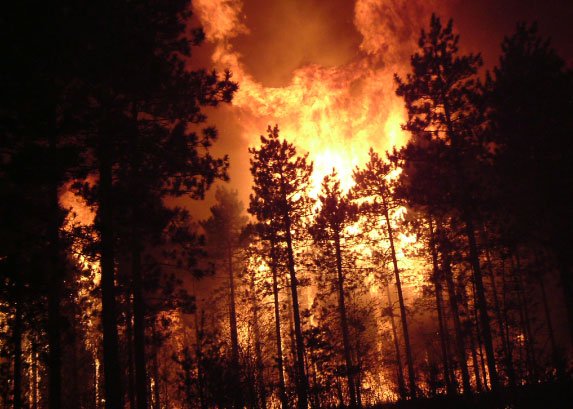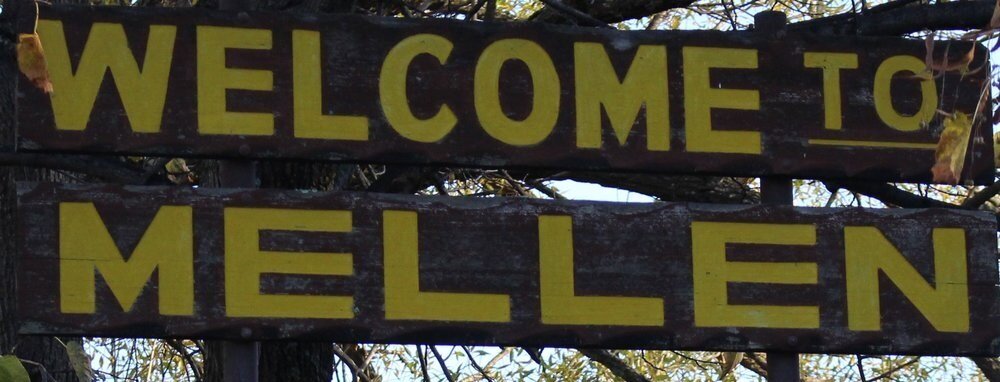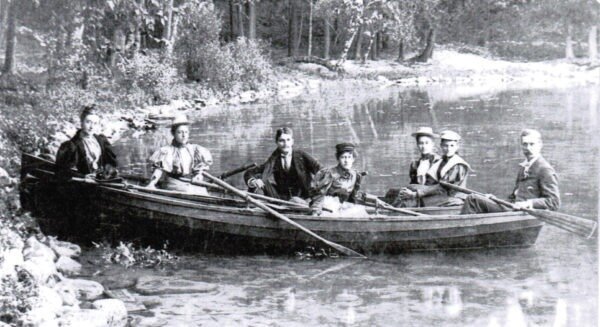Cryptid Profile: The Ivory Billed Woodpecker
In June of 2006, an anonymous reward of $10,000 was made public to anyone who could offer legitimate information and proof of the existence of a specific bird either by its nest, roost, or feeding site. In December of 2008, a larger $50,000 reward was offered to anyone who could lead a biologist to a living specimen of this same bird. What exact bird were these rewards offered in exchange for proof of? One of the most impressive and largest woodpeckers known to exist in modern times, the Ivory Billed Woodpecker.
The Ivory-Billed Woodpecker (Campephilus principalis) was/is one of the largest woodpeckers in the world and was/is the largest in the United States. Because of this, it was at one point referred to as the ‘Lord God Bird’ as well as the ‘Good God Bird' because of the shock people would exclaim when they saw how big the bird actually was. The woodpecker's main habitat was/is the southeastern United States, with the largest population being found in the state of Arkansas. During the birds' verified existence, it was believed to have a range from North Carolina, all the way to Western Texas. Some reports also claim that the bird made its home in Illinois, Ohio, Kentucky, and Mississippi as well. It was most often seen though in locations that consisted of thick old growth forests with hardwood swamps or dense pine forests with an abundance of dead trees.
The description of the Ivory-Billed Woodpecker states that the bird was between 19 and 21in long, and could weigh upwards of around 2lbs. It had an overall wingspan of 30in, and a wing chord length (measured from the bend of the wing to the tip of the longest primary feathers) of 9.3 to 10.4in. The tail of the woodpecker measured between 5.5 to 6.7in, the enormous ivory white bill measured most often between 2.3 and 2.9in, and the legs measured between 1.6 to 1.8in. The bird possessed brilliant yellow eyes which were described as being full of emotion and focus. Researchers of the bird believe that the average lifespan was anywhere between 20-30yrs.
The feathers of the Ivory-Billed Woodpecker were a shiny blue-black and it possessed white markings on its neck and back. A trail of white could also be found on the upper and lower edges of the wings. While both sexes possessed a prominent head crest, it was black on the females and red on the males. Of the two sexes, the males were larger than the females, but both birds operated as one unit. Both helped in the creation of nests as well as in feeding, guarding, and raising of young. The woodpeckers' main diet consisted of beetle larvae but was also found to eat various nuts and berries collected from trees and shrubs. The Ivory-Billed Woodpecker was known to mate for life and showed signs of affection with its mate by clasping their beaks together. At the time of their existence, they had no natural predators except man.
Known by Native Americans for years before Europeans arrived in America, the Ivory Billed Woodpecker was regarded highly for its courage. Because of this, after an Ivory Billed Woodpecker had died, its long bill would be harvested and used as decoration in huts, as jewelry for warriors, and in trade between tribes. Large numbers of skulls of the bird have been found in archaeological digs which show that any item which came from the bird was highly regarded.
In 1712, Englishman Mark Catesby arrived in North America to begin work on a guide which collected information on the native plants and wildlife of the region. During this time, Catesby encountered the Ivory-Billed Woodpecker, and soon after gave the bird the name, “largest white-bill wood-pecker”. In 1794, Scottish immigrant Alexander Wilson came to America to study, document, and paint the native birds of North America. While out in the woods, Wilson also came across an Ivory-Billed Woodpecker, and while originally intending to shoot and kill the bird to study, he instead wounded it. After making the decision to not put the bird out of its misery, Wilson tried to nurse it back to health and keep it as a pet. This would turn out to be much harder than he had anticipated.
Wilson spoke of how he kept the large woodpecker uncaged in his room at a local inn while attempting to mend its wound. While there, the bird nearly destroyed every piece of furniture within the space, put holes in almost every wall, and nearly broke through every inch of the ceiling in a desperate effort to escape. Realizing that the giant bird would eventually find a way out of the room if he did not do something to stop it, Wilson reluctantly tied the bird to the large wooden table in the room. Doing so would prove to be the wrong choice though as the woodpecker focused all its anger on destroying the table and chose to stop eating during this time of destruction. Because of this, it is reported to have died three days after being brought to the inn.
In 1820, famed naturalist John James Audubon and his apprentice shot and collected many Ivory Billed specimens along the Mississippi River region in order to accurately portray and describe them in his paintings and writings. Later, in 1837, Audubon is reported to have once again encountered the woodpecker after claiming to have discovered a thriving population along the Buffalo Bayou in Texas.
Unfortunately, over 50yrs later in the 1870’s, the United States removed laws that unofficially protected the Ivory Billed Woodpecker by preventing timber companies from harvesting trees within protected areas. As soon as the timber industry moved in, the destruction of the woodpecker's forest homes began. Then, to add insult to injury, in the 1890’s, bird collectors began stepping up their efforts to kill the bird in order to harvest the bodies of the woodpecker for not only personal home display, but also for sale as well. Because of these two major actions, the population of the Ivory-Billed Woodpecker started to rapidly decline.
A surprise though came in 1907, when nature loving President Theodore Roosevelt is reported to have come across an Ivory Billed Woodpecker while on a hunting trip in Louisiana. This came as quite the shock to many as a majority of wildlife experts believed the bird to be almost extinct at this point as no sightings of the bird had been made in several years. Later that same year, Arthur A. Allen (founder of the Cornell Laboratory of Ornithology) and his wife Elsa spotted a male and female pair of nesting woodpeckers while in the swamps of Florida. Not wanting to possibly disturb the pair any more than they already had, the Allen’s removed themselves from the area with hopes of returning within a few days. Sadly though, upon hearing the news of the discovery, two taxidermists legally got a permit, went out to the area where the birds were nesting, and shot the pair in order to have them stuffed and sold.
Fast forward 27yrs later to 1932, an attorney and state legislator by the name Mason D. Spencer made it his personal goal to prove that the Ivory Billed Woodpecker was not only still around in the state of Louisiana, but that it was also nowhere near as close to extinction as previously thought. Spencer set off on his mission to find the ‘Lord God Bird’ and after quite the lengthy search, he actually managed to find a healthy adult male specimen that had made its home in the Singer Tract swamp. Obviously excited over his discovery, Spencer celebrated joyfully to himself in the swamp, but as soon as he was done, he loaded his weapon and shot the bird out of its tree. The attorney then retrieved the body and took it to the offices of Louisiana state wildlife officials to show them face to face that the Ivory Billed Woodpecker was still living in their swamps.
This unfortunate trend of searching and killing continued on well into the late 1930’s, and after being combined with years of deforestation the bird was officially thought to finally be extinct. But then in 1938, a 24yr old ornithologist (a scientist who studies birds) by the name of James Tanner compiled stacks of research and information on the woodpecker in which he hoped could prove the bird was still alive. After presenting his plan to wildlife officials and professors at Cornell University, Tanner was able to launch a mini expedition into the swampland and virgin forests of Louisiana in hopes of finding the Ivory Billed Woodpecker alive and well.
After days of searching for the bird that most believed had died out, Tanner and his game warden guide J.J. Kuhn, unbelievably discovered one of its nests high up in a gum tree. Not only were the two men able to document a breeding pair was in the area, but they were also able to verify the existence of the pair's baby by the way the adults kept bringing food to their hollow tree home. Knowing he would need official photographic documentation of the juvenile bird, Tanner and Kuhn set up camp and watched the nest for nearly two weeks. Growing tired of waiting, Tanner took a chance in climbing the tree in order to view the juvenile after the parents had gone to retrieve food.
As the young man approached the opening of the nest nearly 55ft off the ground, he pulled back a branch in order to get a good view inside. Suddenly though, the infant bird shot out of the opening in a panic and dropped to the ground below. Thankfully, during its descent, it managed to get tangled in a series of vines hanging from the tree which cushioned its fall to the forest floor below. Tanner, understandably nervous and concerned, descended the tree in order to make sure the young woodpecker was ok, and miraculously, it was.
After untangling the infant woodpecker from the mess of vines, Tanner handed the little ‘Lord God Bird’ to Kuhn while he retrieved his camera. When he returned, he found the little bird had made itself comfortable on not only the shoulder, but also the arm, the back, and the head of Kuhn. This resulted in an impressive series of photographs of not only a bird that was thought to be extinct, but a rarely seen juvenile at that. After taking nearly a dozen photographs, Tanner returned the bird to its nest and the pair made their way back to their homes.
Once he arrived back home, Tanner got to work compiling his data from the expedition. After going over the numbers and double checking them, Tanner estimated that there were more than likely no less than 30 Ivory Billed Woodpeckers left in the United States. This data, along with the crucial pieces of photographic evidence was enough to get the National Audubon Society to launch an official campaign for the protection of the Ivory Billed Woodpecker.
Sadly, after a much too late effort to save the woodpecker, they were once again thought to be nearly extinct as of 1940. Then, after 27yrs of hoping a population would be discovered safe from man and out of harm's way, the Ivory Billed Woodpecker was officially listed as a critically endangered species in 1967. The reason for this labeling is due to the fact that during those 27yrs of hope, there had been no new photographic/video evidence, genetic evidence (feathers or feces), or discarded evidence (nests or egg shells).
But just because the bird was listed as critically endangered, this has not stopped some groups from hoping it will yet again come back. The reasons for this belief are due to recent land acquisitions by states in which the bird was known to call home, as well as woodpecker habitat restoration efforts in areas where there is a high probability a group may have survived. These groups also hold out hope for rediscovery based on the history of other animals once thought to be extinct, but found alive and well years later. Example of these creatures include the New Guinea highland wild dog, the Arakan forest turtle, the Lorde Howe Island stick insect, the famous coelacanth, and most recently, the Zanzibar leopard.
While many people consider the critically endangered Ivory Billed Woodpecker to actually be extinct (and wish for its status to change to extinct), sightings of the bird continue to this day. Between 1950 and 1970, over 12 sightings were made between Georgia and Florida. In 1971, a photograph showing a possible male on a tree was taken in Louisiana. A sighting was made in 1994 in Alabama. In 1999, a pair of woodpeckers thought to be Ivory Bills were spotted in Southeast Louisiana. In 2002 the unique call and rapping sound the woodpecker makes was heard by LSU biologists in the Louisiana swamps. In 2004, a large woodpecker with the white wing markings like that of an Ivory Billed Woodpecker was videotaped flying around In Arkansas. Between 2004 and 2005, a possible male Ivory Bill was discovered in Arkansas. An ornithologist noted seeing an “unusually large red-crested woodpecker” in the Big Woods area and this lead to a 14-month expedition into rediscovering the bird. During this time, over fifteen sightings were made of a possible Ivory-Billed Woodpecker. In 2006, 14 sightings of a possible Ivory Billed Woodpecker were made in Florida.
The sightings above are only a few of the many that continue to be reported. To this day, bird watchers in remote locations claim to occasionally see a ‘Good Lord Bird’ flying around its once known habitat. But as will most extremely rare creatures, the evidence to prove its existence is often lacking. But that doesn’t mean hope is lost, as there are those who are dedicated and will continue to search for the bird until it is once again verified as alive and well.
Besides, after the many failed assumptions that the Ivory Billed Woodpecker had gone extinct only for it to come back again years later, it is safe to assume that the ‘Good Lord Bird’ is also part phoenix. Because apparently it enjoys constantly rising from the ashes and surviving in a world obsessed with ending it.
-The Pine Barrens Institute
*Image Credit: Google
Do you have a strange tale, family legend, or odd sighting you would like to report? Get in touch with us here to share what you know!
Want more strange stories in your life? If the answer is yes, then make sure to check out our books ‘Monsters In Print: A Collection Of Curious Creatures Known Mostly From Newspapers’ and ‘Ghosts In Print: An Assemblage of Spirits, Spooks, and Specters From Newspapers of Old’, both available from Amazon!
Make sure to also check out our shop for official PBI shirts, totes, buttons, and stickers!































